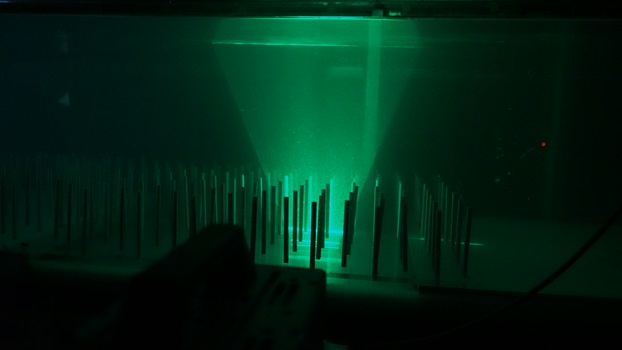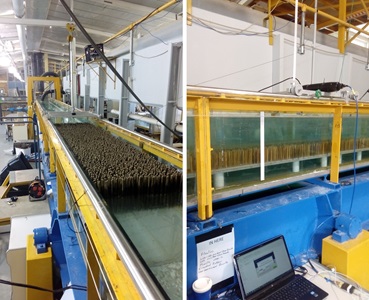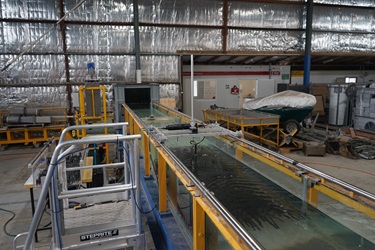
-
Highlights
-
Governance
-
Chancellor
-
Vice-Chancellor
-
Executive
-
History of the University
-
Schools
-
Campuses
-
Complaints
-
Official publications
-
Communications and marketing
-
Working at UWA
Other Equipment
A range of additional experimental facilities (including recirculating current flume), and a suite of auxiliary instrumentation (wave gauges, Acoustic Doppler Velocimeters (ADV), Particle Image Velocimetry (PIV) and other instrumentation that can be custom-tailored to applications).
Facility Specifications
- Current flume: 25m long, 0.6m wide and 0.5m deep
- Mean currents up to 50 cm/s
- A plunger-type wave maker for wave-current interaction studies
- Glass walls for optical flow measurements
- Laser enclosure for highresolution LDA/PIV/PTV measurements
- Capacity to examine small-scale biophysical processes, including flow-biota interactions, sedimentwater mixing processes and sediment transport
Previous Research Projects
- Characterization of the Bottom Boundary Layer in vegetated flows
-
The bottom boundary layer (BBL) is the layer of water adjacent to the bottom sediment, this layer is generated due to the friction between the water motion and the sediment bed. The physical structure of this layer has an influence on several critical physicals, chemical and biological processes at or near the bed such as sediment transport, hyporheic exchange and biofilm formation among others.
Due to its importance, the structure of the BBL layer was investigated for bare bed and vegetated flow conditions using the Constant Flow Flume at COEL. High-resolution PIV measurements along with the construction of a physical model of vegetation were used to study the vertical structure of the velocity, stresses and turbulent kinetic energy for different flow conditions and vegetation density within the BBL.
Key contact: Mario Conde-Frias
Email: [email protected]

- Detailed measurement of forces in aquatic vegetation
-
Aquatic vegetation (such as mangroves, seagrass, and salt marshes) plays a crucial role in affecting the local water flows in rivers, estuaries, and coastal regions, and indirectly influences sediment transport as well as biophysical processes. To be able to predict the influence of vegetation, we need to improve our understanding of the forces that act on the vegetation and vice versa. In this experiment we utilized the 25m long Constant Flow Flume to obtain detailed measurements of flow velocities and vegetation forces for a range of conditions, including submerged (e.g. seagrass) and emergent (e.g. salt marsh, mangroves) type vegetation. The results were used to validate and improve a theoretical model that can help coastal managers to predict the effect of aquatic vegetation on local water flows.
Key contact: Arnold Van Rooijen
Email: [email protected]

- Calibrating Acoustic Doppler Velocimeters (ADV)
-
ADV are calibrated using the 25m long steady state current flume. Calibration is conducted using the common method of, collecting measurements with the supplied instrument and comparing the results to well calibrated instruments. A comparison is made simultaneously or nearly simultaneously, using a suite of instruments such as other well-calibrated ADV and flow calibration meters. The availability of high quality research infrastructure and research staff with extensive experience in ADV use, ensures calibrations are conducted to the highest standard.

Current Projects
- Flow visualisation and detailed flow measurements
- Sediment transport studies
- Description of flow resistance, turbulence and vertical mixing in flows through vegetation canopies
- Testing prototype anti-scour mats


































